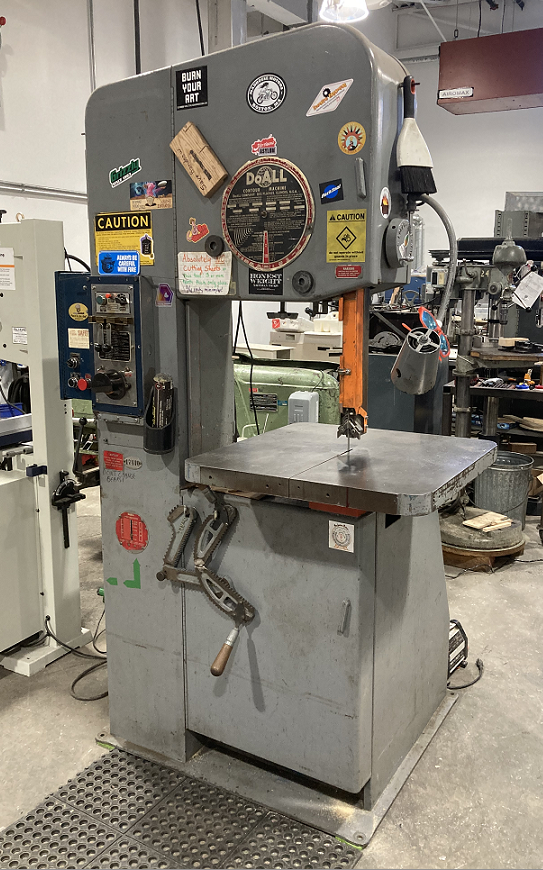Category:TIG Welders and Do-All Vertical Bandsaw: Difference between pages
No edit summary |
No edit summary |
||
| Line 1: | Line 1: | ||
[[Category:Tools]][[Category: | [[Category:Tools]][[Category:Vertical Band Saws -- Metal Cutting]] | ||
Link to:[[:Category:Machine Shop | Machine Shop Main Page]] | |||
{{EyeWarning}} | {{EyeWarning}} | ||
{{ToolBox|tool_title= | {{ToolBox | ||
the | |tool_title = Do-All Vertical Band Saw | ||
|tool_subtitle = Do-All 15-inch | |||
testing] | |image = Band_Saw_Do_All.png | ||
|caption = The Do-All band saw in the Machine Shop | |||
|make = Do-All | |||
|model = 2013-10 | |||
|serial = | |||
|manufacturer_specs = | |||
|manual = [https://drive.google.com/file/d/1qBt49XPYsiW2hlNmfIKo9qQoE0dEjLP1/view?usp=drive_link Instruction Manual for a Similar Model] | |||
|location = Machine Shop | |||
|rubric = N/A | |||
|training = | |||
|testing = [https://www.artisansasylum.com/tool-testing Tool testing] | |||
|restrictions = red | |||
|tool_categories = [[:Category:Vertical Band Saws -- Metal Cutting | See the Vertical Band Saws category for notes on using saws of this kind.]] | |||
}} | |||
=Description= | |||
This machine is a treasured antique. | |||
=Safety= | |||
[ | Link to: [[:Category:Vertical_Band Saws_--_Metal_Cutting#Safety | Safety notes on the Metal-Cutting Vertical Band Saws category page]] | ||
{| class="infobox" cellspacing="5" style="width: 12em; text-align: left; font-size: 100%; line-height: 1.5em;" | |||
! colspan="2" class="infobox-image" | [[File:Band_Saw_Do_All_self_docu.jpg|180px| Do-all_self_docu]] | |||
|- | |||
| colspan="2" | This machine is largely self-documenting. | |||
|- | |||
|} | |||
=Operation= | |||
= | |||
The Do-All is extravagantly decorated with hipster stickers and reminders that instruct the operator what to do. | |||
==Power== | |||
To start the saw, find the power buttons on the back of the machine. | |||
{| class="infobox" cellspacing=" | {| class="infobox" cellspacing="5" style="width: 12em; text-align: left; font-size: 100%; line-height: 1.5em;" | ||
! colspan="2" class="infobox-image" | [[File: | ! colspan="2" class="infobox-image" | [[File:Band_Saw_Do_All_power_switch.png|180px| Do-all_ power switch]] | ||
|- | |- | ||
| colspan="2" | | | colspan="2" | The power switch is around back. | ||
|- | |- | ||
|} | |} | ||
==Speed Selection== | |||
The machine is usually set to cut mild steel, for other materials it may be necessary to change the blade speed. | |||
{| class="infobox" cellspacing="5" style="width: 12em; text-align: left; font-size: 100%; line-height: 1.5em;" | |||
! colspan="2" class="infobox-image" | [[File:Band_Saw_Do_All_All_Human_Knowledge.jpg|200px| Do-all speed calculator]] | |||
{| class="infobox" cellspacing="5" style="width: | |||
! colspan="2" class="infobox-image" | [[File: | |||
|- | |- | ||
| colspan="2" | | | colspan="2" | This tool was bequeathed to us by our ancestors. May it serve you well. | ||
|- | |- | ||
|} | |} | ||
* The | * The first step is to find what speed is needed. | ||
Blade speed data may be found from a wide variety of sources. Although it isn't as clear as others, the Do-All has a mechanism on its side panel that is well worth examining. It shows how your great-grandparents did these things. Devices like this are as rare as they are baffling. | |||
* | * Next the operator checks the current blade speed. An indicator on the lower left side of the machine reads in feet per minute. | ||
This indicator only registers while the machine is running. | |||
{| class="infobox" cellspacing="5" style="width: 12em; text-align: left; font-size: 100%; line-height: 1.5em;" | |||
{| class="infobox" cellspacing="5" style="width: | ! colspan="2" class="infobox-image" | [[File:Band_Saw_Do_All_speed_adjustment.png|140px| Do-all speed adjust]] | ||
! colspan="2" class="infobox-image" | [[File: | |||
|- | |- | ||
| colspan="2" | | | colspan="2" | The crank is almost invisible around the back of the machine. | ||
|- | |- | ||
|} | |} | ||
{| class="infobox" cellspacing="5" style="width: 12em; text-align: left; font-size: 100%; line-height: 1.5em;" | |||
! colspan="2" class="infobox-image" | [[File:Band_Saw_Do_All_speed_indicator.png|220px| Do-all speed indicator]] | |||
{| class="infobox" cellspacing="5" style="width: | |||
! colspan="2" class="infobox-image" | [[File: | |||
|- | |- | ||
| colspan="2" | | | colspan="2" | Feet per minute. Note only the '''LOW''' speed range is available. | ||
|- | |- | ||
|} | |} | ||
* To change the speed the operator must reach around the left side of the machine and find a crank down near the bottom. | |||
This crank must '''ONLY''' be turned when the machine is running. It uses a similar linkage to the spindle transmissions in a vertical milling machine. | |||
* Another crank located behind the machine is clamped down because it is no longer used. This was formerly a lever to change the speed range from "LOW" to "HIGH." On this machine the "HIGH" speed range has been disabled. | |||
Revision as of 21:17, 16 March 2024
Link to: Machine Shop Main Page
| Eye protection required! | ||
|---|---|---|
| Do-All Vertical Band Saw | |
|---|---|
| General Info | |
| Make | Do-All |
| Model | 2013-10 |
| Serial | |
| Specs | |
| Manual | Instruction Manual for a Similar Model |
| Asylum Info | |
| Location | Machine Shop |
| Rubric | N/A |
| Training | |
| Testing | Tool testing |
| Restrictions | red |
See the Vertical Band Saws category for notes on using saws of this kind.
Description
This machine is a treasured antique.
Safety
Link to: Safety notes on the Metal-Cutting Vertical Band Saws category page
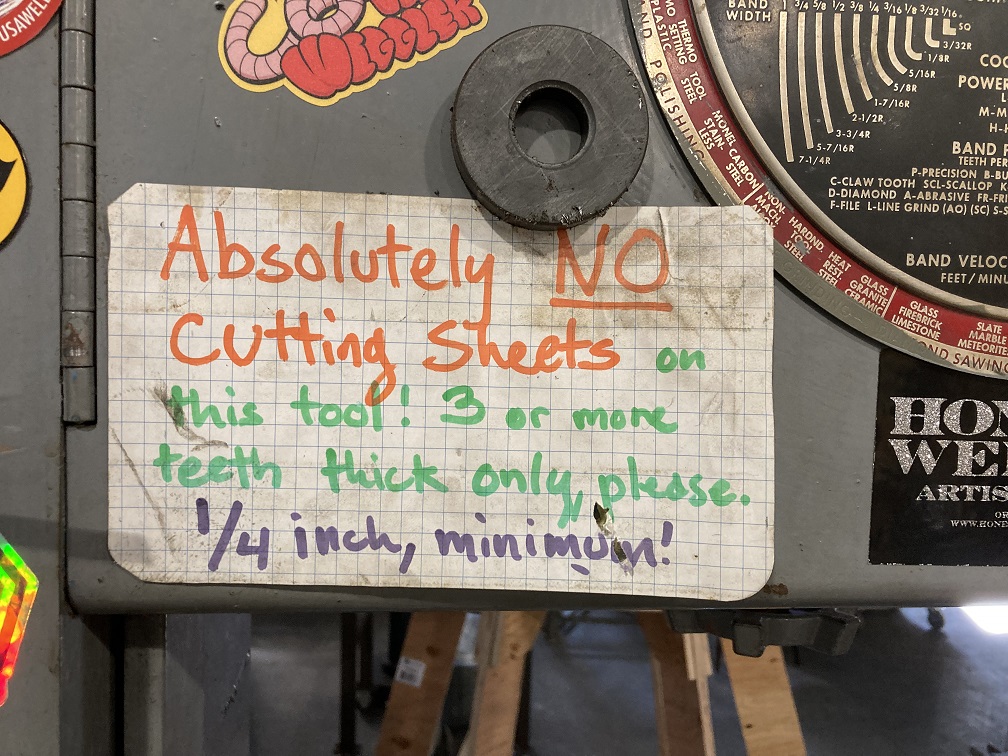
| |
|---|---|
| This machine is largely self-documenting. |
Operation
The Do-All is extravagantly decorated with hipster stickers and reminders that instruct the operator what to do.
Power
To start the saw, find the power buttons on the back of the machine.
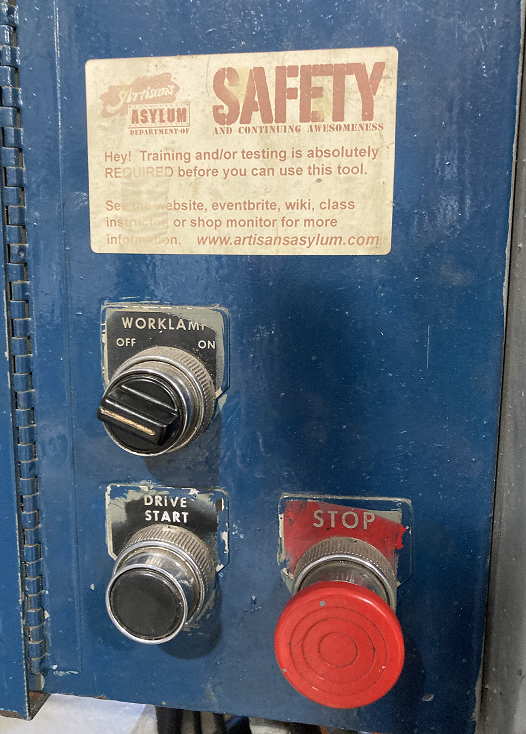
| |
|---|---|
| The power switch is around back. |
Speed Selection
The machine is usually set to cut mild steel, for other materials it may be necessary to change the blade speed.
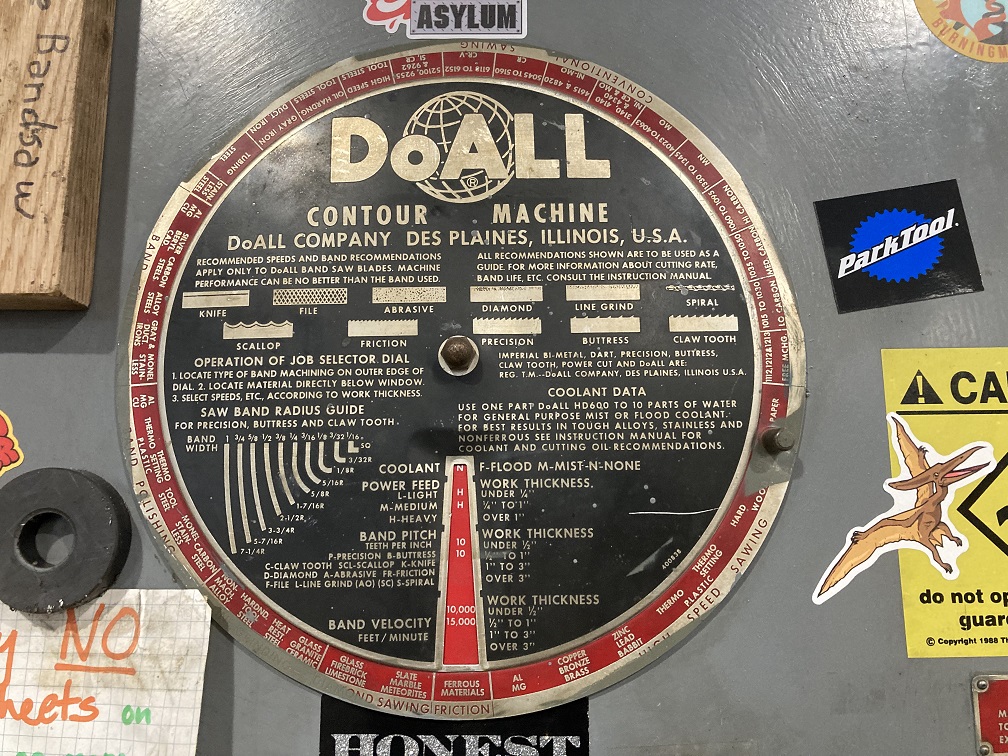
| |
|---|---|
| This tool was bequeathed to us by our ancestors. May it serve you well. |
- The first step is to find what speed is needed.
Blade speed data may be found from a wide variety of sources. Although it isn't as clear as others, the Do-All has a mechanism on its side panel that is well worth examining. It shows how your great-grandparents did these things. Devices like this are as rare as they are baffling.
- Next the operator checks the current blade speed. An indicator on the lower left side of the machine reads in feet per minute.
This indicator only registers while the machine is running.
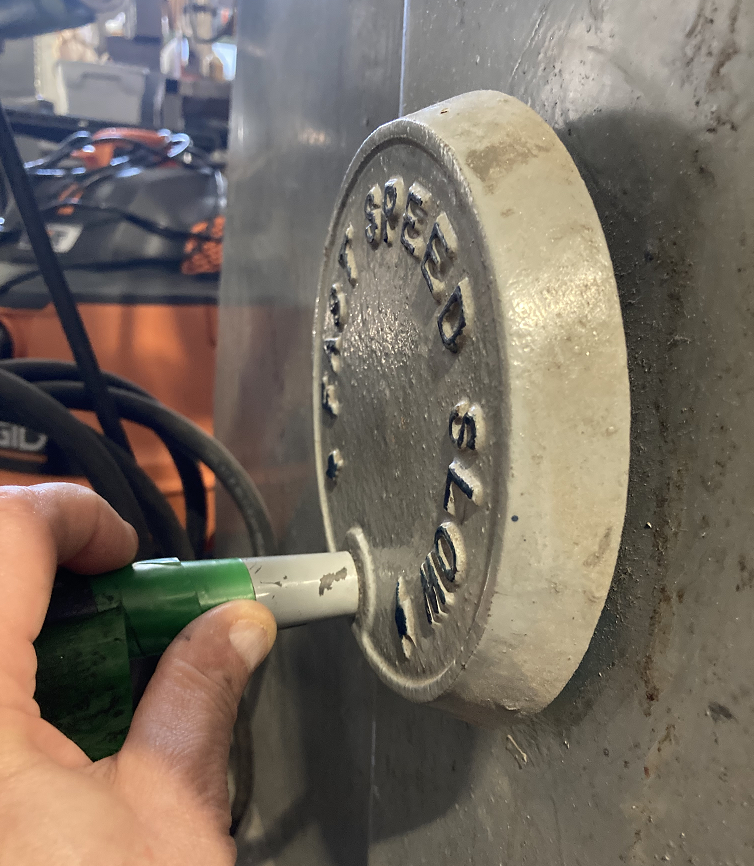
| |
|---|---|
| The crank is almost invisible around the back of the machine. |
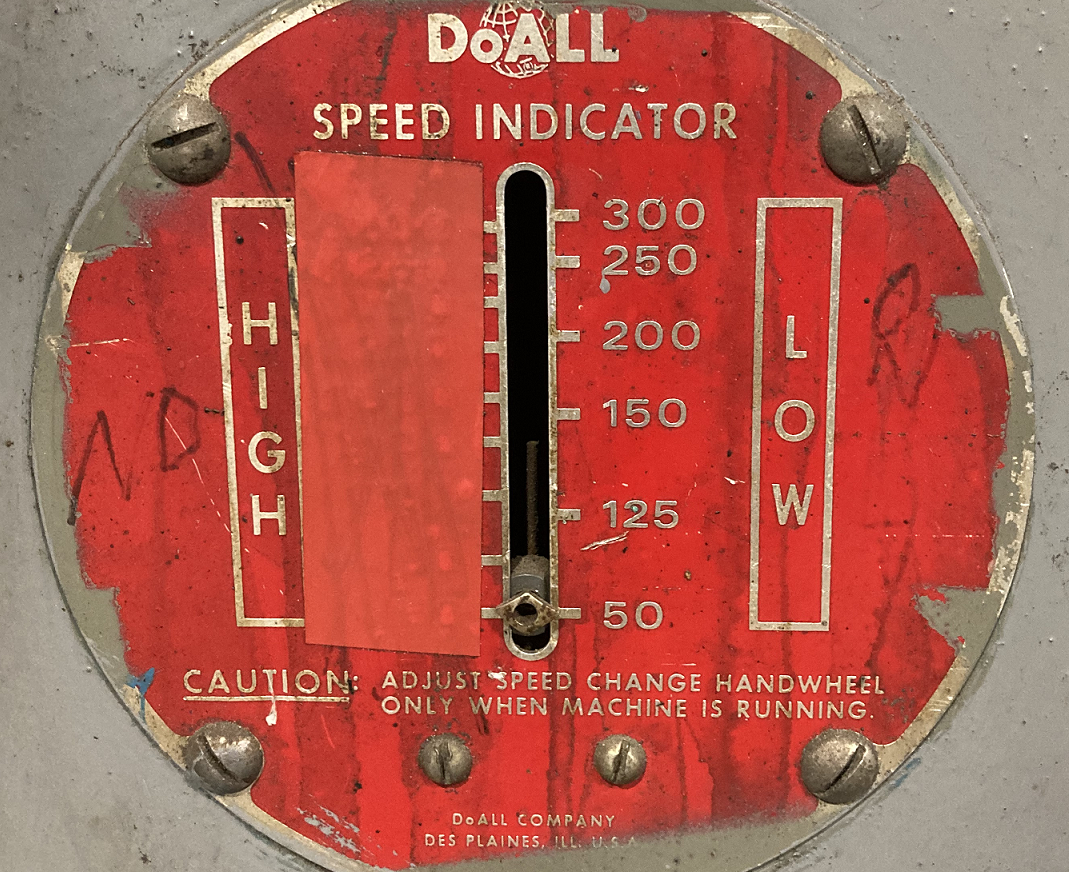
| |
|---|---|
| Feet per minute. Note only the LOW speed range is available. |
- To change the speed the operator must reach around the left side of the machine and find a crank down near the bottom.
This crank must ONLY be turned when the machine is running. It uses a similar linkage to the spindle transmissions in a vertical milling machine.
- Another crank located behind the machine is clamped down because it is no longer used. This was formerly a lever to change the speed range from "LOW" to "HIGH." On this machine the "HIGH" speed range has been disabled.
Pages in category "TIG Welders"
The following 4 pages are in this category, out of 4 total.
